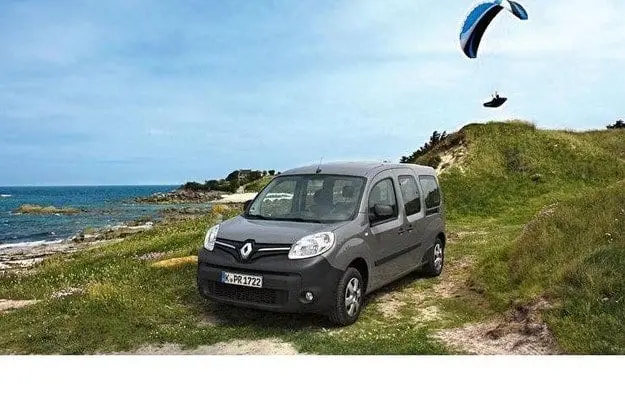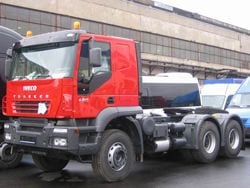
Test drive Renault Grand Kangoo dCi 110: really big

Two years and 100 km with the popular large passenger van
For two years Renault Grand Kangoo has faithfully served in our editorial office, for example, as a carrier of photographic equipment, assistant for changing homes, carrying tires, a stroller and a passenger bus. Balance after 100 km of run.
When Renault unveiled the new Grand Kangoo with an extended wheelbase in 2012, the 15-year-old pictures from the market premiere of the van, transport van and passenger van range were still in our minds. At the time in the ad, a loving rhinoceros climbed onto the back of the fourth French model and gently swayed his senses like a rhino. The message from the hilarious TV spot was "Kang is invulnerable."
Seven-seat space
This raw display of strength and genetics also led to the question of how the Grand Kangoo would perform in our marathon test. Shortly before Christmas 2014, that moment came - the car with the number K-PR 1722 was placed in a garage with tested models, and for the next 100 km there was a super-spacious offer for all cargo and passenger purposes.
To the then base price of 21 euros - today it is 150 euros - were added: Easy Drive package (21 euros for the on-board computer and cruise control), rear parking sensors (400 euros), full spare wheel (250 euros), functional package ( 350 euros) for a folding driver's seat and tables in the front seatbacks, maps for Europe (70 euros), a multimedia system including TomTom navigation (200 euros), heated driver's seat (120 euros) and a safety net (590 euros).
Always at your service
The first look at the end of the marathon test is directed to a folder that contains the technical biography of the participant in the form of copies on thin paper, along with all damages for the period. On the Grand Kangoo, after 100 km, there were only a few brief remarks: from time to time, for no apparent reason, the navigation system was turned off, two burned-out H000 lamps, wipers and 4 km of front brake discs were replaced. and overlays. This wear and tear seems to be in order - after all, Grand Kangoo travels on the highway at speeds up to 59 km / h and can carry up to 572 kg, i.e. rolling mass reaches 170 tons.
The facts show that Kangoo never got stuck on the road or visited a service station outside of the usual schedule and thus fought for one of the first places in the eternal ranking of vans. With a damage index of 2,5, the Frenchman lost twice the more expensive VW Sharan and Ford C-Max Ecoboost in an honorable third place, ahead of such competitors as Opel Zafira (3), Toyota Corolla Verso (5,5) and VW Multivan (19).
Editor Uli Baumann uncloudedly describes the friendly nature of this Renault as follows: “Its design is a vision, but the overall idea of the Grand Kangoo is sensational. To the question “Can we take this too?” in practice it is never placed, because there is always more than enough space. The concept, with two sliding rear doors and a double tailgate, proved to be particularly suitable for everyday use. The 110 hp diesel engine is also convincing. This gives the Kangoo enough power and is economical. Ride comfort is decent too. Everything seems pragmatic and solid—or almost everything. The rear mats started to fall apart after 7000 km and the front ones are constantly walking due to poor fixation.” This relatively early statement aptly reflects the opinion of the editorial board about this undemanding draft animal.
The bodywork also remained at an acceptable level for a passenger van - that is, without squeaking when walking over hilly bumps, as well as without bumps and scratches as a sign of wear. Only the tailgate rollers moved more and more freely in the guides over time, so the French model imitated the sound of closing the VW "Bully" of the T2 generation almost perfectly.
The paintwork is largely unaffected by the frequent pebbles and the versatile van is enjoyable to drive even after hours of driving, and on long business trips, the seats don't turn into torture chairs. While they don't provide enough lateral support, they are otherwise satisfactorily padded and spring loaded. After 100 kilometers, the driver's seat is noticeably worn out, but neither the driver nor the passengers are held by the belts on the soft padding.
Mysterious crackle
Before we move on to minor annoyances, a few more words about tires. The Pirelli Snow Control 3 winter team had to prove their worth (set price €407,70); in the warmer months we relied on the standard Continental VancoContact 2. Both sets showed another 20 percent profile depth at the end of the test - the Continental after 56 and the Pirelli after 000 kilometers. Both products received positive reviews for durability, wet grip and handling precision.
However, a temporary concern was caused by an acoustic phenomenon, which young and original-looking testers described as follows: "After 60 kilometers, a malfunction signal sounded under the front fenders of the Grand Kangoo." Seniors seek refuge in the observation that a suspicious crack on the front axle appears from time to time when turning the steering wheel. Tie rod ends, shank bolts, motor suspension? Everything is good. Perhaps only one of the sources was spinning loudly in its socket. At some point, the noise disappeared as mysteriously as it appeared.
Big hit
Minor inconveniences such as a loose infotainment controller, insufficient heating power for rear seat passengers, noticeable aerodynamic noise and vibration of the front cover at high speed are easily forgiven in the Grand Kangoo. Due to its low price, acceptable fuel consumption in terms of dimensions (6,9 l / 100 km) and a spacious car, it is the recommended choice for everyone who sees their earthly paradise in the vastness of space.
This is how readers rate the Renault Grand Kangoo
Where is the best value for money? Our family (with three children) most often drives Kangoo 1.6 16V as a second car with first registration 8/2011, which we bought for two years from a private person for 9000 euros. Thanks to the fourth design, the car is indispensable in everyday life - a five-seater seat with luggage for the holidays, 4,20 meters long. Added to this are sliding doors and a sense of air and space, so children get here much more willingly than in various cars of my company. In the Luxe configuration, the car is quite pleasant - with an automatic, leather steering wheel and built-in navigation.
While (52 km) walks without defects, I visited the service center only for regular maintenance and when the parking alarm was installed. Comfort is good, the seats are comfortable, everyday usefulness in our world of Ikea and other furniture stores is inexhaustible. We took advantage of this in the previous model, in which the strollers simply went inward without folding or even lifting.
The weak point is the bike. In fact, its power is quite enough, but one can hardly believe that it has 106 hp. – you feel that it is overloaded and it needs strong acceleration of the gas. The result is an unacceptable consumption of about ten liters per 100 km. This is surprising, because the same engine of the previous model (where it developed 95 hp) was much more maneuverable and its consumption was about eight liters. We drove this Kangoo for twelve years, after which it went without any rust to my wife's parents in Poland, where he continues to leave. And the accident statistics that we have read are just statistics.
My conclusion: I would always buy the same Kangoo again, but with 115 hp. or 110 hp diesel We love the high seating position and the sliding doors. The comfort is good, the quality - and even at such prices, probably, no one would have expectations as from an elite brand.
Lars Engelke, Achim
We have been driving Grand Kangoo since March 2014 and are absolutely satisfied. In terms of plenty of places – you can travel as seven adults without getting claustrophobic – as well as an economical bike that consumes an average of 6,4 liters per 100 km.
The rear doors are very practical, and after all, people like the Kangoo simply for the space and comfort, not for any electronics. Compared to our previous vehicles (we had two VW Touran vans and one Renault Grand Scenic), our Grand Kangoo stands out for its practical simplicity and lack of pretentiousness. Brilliantly simple, simply brilliant - this is the most appropriate definition.
Ralph Schuard, Ashheim
Advantages and disadvantages
+ Plenty of space for driver, passengers and a lot of luggage
+ Good dynamic performance
+ Moderate fuel consumption for a van of this size
+ Numerous spacious places for little things
+ Box between the front seats
+ Reliable workmanship
+ Sufficiently powerful diesel engine with satisfactory torque
+ Correctly tuned, easily switchable 6-speed gearbox
+ Headlights without tools (H4)
+ Decent suspension
+ Relatively agile for its size
+ Good view forward and sideways thanks to large windows
+ Flat floor with folded middle seats
+ Full seven-seater model
– Complex and complex manipulations with pressing and rotating the controller
– Wears unbearably and does not attach well to front mats
– Perceptible aerodynamic noise at high speed
– Impractical luggage tray in the front of the ceiling, suitable only for clothes
– The tank cap is not integrated into the central locking.
Conclusion
Cheap, economical, reliable and takes up as much space as you need
The Renault Grand Kangoo has earned a place in people's hearts in the newsroom. The car did not stop at any adventure - carrying paragliders, shelter and a garage at the Le Mans pilots camp, where the Honda Monkey and a weary sports editor took refuge. Mercedes makes it their Citan – and testifies to the longevity of Renault's engine and transmission. A model who knows a lot and whose little weaknesses are easy to excuse.
Text: Malte Ûrgens
Photo: Jurgen Decker, Dino Eisele, Rosen Gargolov, Klaus Mühlberger, Arturo Rivas, Hans-Dieter Soifert, Sebastian Renz, Gerd Stegmaier, Uwe Seitz

